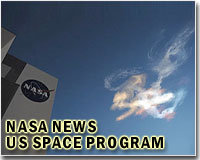 |
Washington DC (SPX) Jun 10, 2010 NASA has selected 18 innovative technology proposals for negotiation of Phase 2 contract awards in the Small Business Technology Transfer program, or "STTR." The selected projects have a total value of approximately $11 million. The contracts will be awarded to 18 high technology firms that are partnering with 15 universities in 12 states. As an investment opportunity, STTR innovations address specific technology gaps in mission programs, provide a foundation for future technology needs, and are complementary to other NASA research investments. Examples of some STTR technologies being pursued in current selected proposals include: - An autonomous health monitoring system for improved stability, safety, and performance of advanced aerospace vehicles under adverse conditions - Advanced components for direct-detection LIDAR (Light Detection And Ranging) that can be used on new unmanned aircraft systems or aircraft platforms. LIDAR instruments will be required for remote sensing measurements from future Earth science missions - Development of novel fabrication techniques for high efficiency thermo-electric devices. More efficient thermo-electric devices which convert heat directly into electricity are of interest to NASA for extracting power from "wasted heat" - heat energy from turbine engines, the hot side of spacecraft, or even the body heat of astronauts. Participating firms and research institutions submitted 31 Phase 2 proposals. The criteria used to select the winning proposals included technical merit and innovation, Phase 1 results, value to NASA, commercial potential, and company capabilities. The STTR program is a highly competitive, three-phase award system. It provides qualified small businesses - including women-owned and disadvantaged firms - with opportunities to propose innovative ideas that meet specific research and development needs of the federal government. In addition, the STTR program requires a collaborative research effort between small businesses and research institutions. Phase 1 is a feasibility study to evaluate the scientific and technical merit of an idea. Awards are for up to 12 months in amounts up to $100,000. Phase 2 expands on the results of the development in Phase 1. Awards are for up to two years in amounts up to $600,000. Phase 3 is for the commercialization of the results of Phase 2 and requires the use of private sector or non-STTR federal funding. Wednesday's NASA awards are for the second-phase in this competitive process. NASA's Office of the Chief Technologist, through its Innovative Partnerships Program, has oversight of the STTR program as part of its focus on emerging technologies and efforts to advance technological innovation for agency purposes. NASA partners with U.S. industry to infuse innovative technologies that result from the STTR program into agency missions and help transition technologies into commercially available products and services for other markets. NASA's Ames Research Center in Moffett Field, Calif., manages the STTR program, with individual projects managed at each of NASA's field centers.
Share This Article With Planet Earth
Related Links List of selected companies NASA's Office of the Chief Technologist Space Tourism, Space Transport and Space Exploration News
 NASA plans 'Summer of Innovation'
NASA plans 'Summer of Innovation'Pasadena, Calif. (UPI) Jun 2, 2010 The U.S. space agency says it's planning its "Summer of Innovation" initiative to engage U.S. middle school students and teachers in science-based education. The program starts June 10 at NASA's Jet Propulsion Laboratory in Pasadena, Calif. The goal, officials said, is to increase the number of future scientists, mathematicians and engineers with an emphasis on broadening participation ... read more |
|
| The content herein, unless otherwise known to be public domain, are Copyright 1995-2010 - SpaceDaily. AFP and UPI Wire Stories are copyright Agence France-Presse and United Press International. ESA Portal Reports are copyright European Space Agency. All NASA sourced material is public domain. Additional copyrights may apply in whole or part to other bona fide parties. Advertising does not imply endorsement,agreement or approval of any opinions, statements or information provided by SpaceDaily on any Web page published or hosted by SpaceDaily. Privacy Statement |